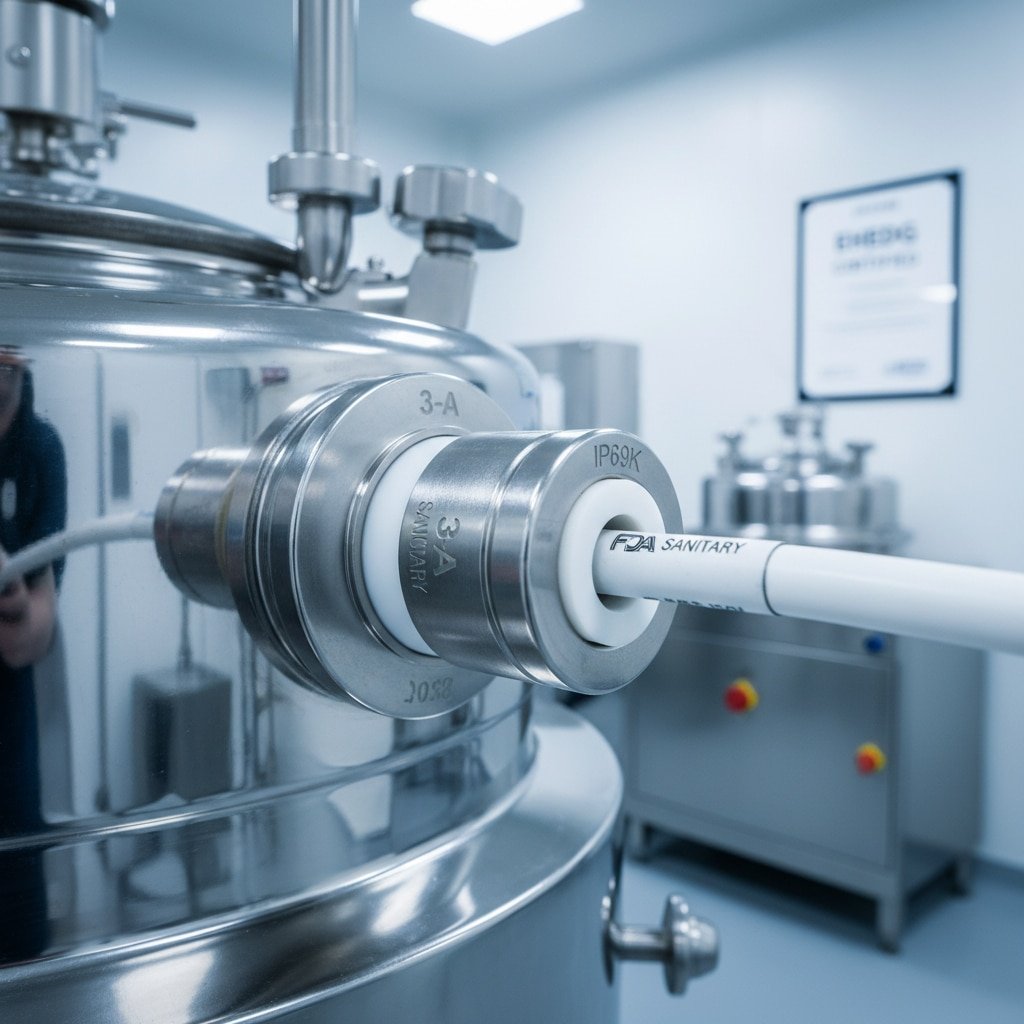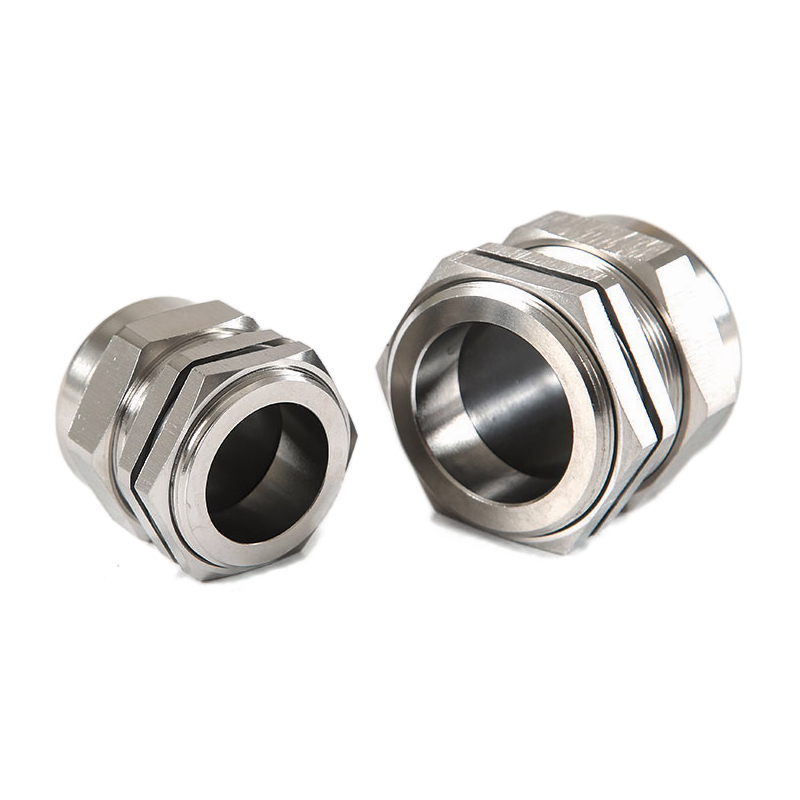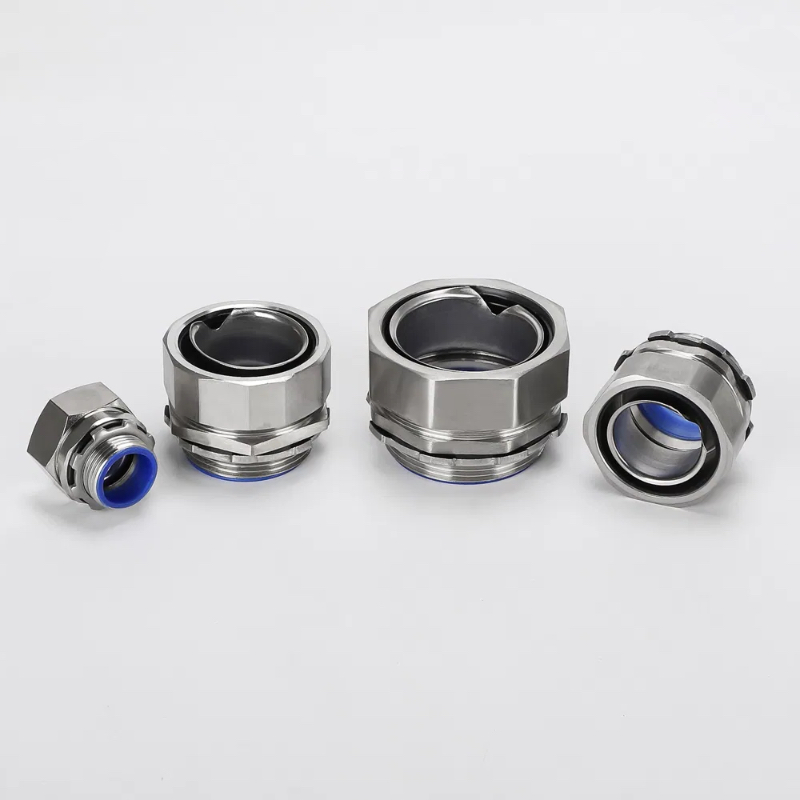Contamination in food processing facilities can shut down entire production lines, trigger costly recalls, and destroy brand reputation overnight. Standard industrial cable glands with crevices, rough surfaces, and non-food-safe materials become breeding grounds for bacteria, creating serious health risks and regulatory violations that can cost millions.
Hygienic design cable glands for food and beverage processing feature smooth surfaces, FDA-approved materials, easy cleaning access, and specialized sealing systems that prevent bacterial growth while maintaining IP ratings and electrical performance in washdown environments. These specialized glands meet EHEDG1, 3-A Sanitary Standards2, and FDA requirements for direct and indirect food contact applications.
Having worked with major food processors across Europe and North America—from dairy plants to beverage bottling facilities—I’ve seen how the right hygienic cable glands can mean the difference between seamless production and devastating contamination incidents. Let me share the essential knowledge every food industry engineer needs.
Table of Contents
- What Makes Cable Glands Hygienic for Food Processing?
- Which Materials and Certifications Are Required?
- How Do Washdown Requirements Affect Cable Gland Selection?
- What Are the Key Design Features for Easy Cleaning?
- How to Ensure Proper Installation and Maintenance?
- FAQs About Hygienic Cable Glands
What Makes Cable Glands Hygienic for Food Processing?
Hygienic cable glands eliminate bacterial harborage points through smooth surfaces, rounded edges, self-draining designs, and food-grade materials that can withstand aggressive cleaning chemicals and high-temperature sanitization cycles.
Understanding hygienic design principles is crucial because even microscopic contamination can multiply rapidly in food processing environments, creating serious health hazards.
Core Hygienic Design Principles
Surface Finish Requirements: Hygienic glands feature electropolished stainless steel surfaces with Ra values typically below 0.8 micrometers. This ultra-smooth finish prevents bacterial adhesion and enables effective cleaning with standard CIP (Clean-in-Place)3 procedures.
Crevice Elimination: Traditional cable glands have threads, joints, and seal grooves that trap contaminants. Hygienic designs minimize these harborage points through continuous welds, smooth transitions, and accessible seal areas that can be thoroughly cleaned.
Self-Draining Geometry: Hygienic glands incorporate sloped surfaces and drainage features that prevent water accumulation. Standing water creates ideal conditions for bacterial growth, making proper drainage essential for food safety.
Material Compatibility: All wetted surfaces must use FDA-approved materials that resist corrosion from cleaning chemicals, maintain integrity during thermal sanitization, and won’t leach contaminants into food products.
I remember working with Sarah, a plant engineer at a major dairy processing facility in Wisconsin. Her facility failed a FDA inspection due to bacterial contamination traced to standard cable glands with rough surfaces and deep thread grooves. After upgrading to our hygienic stainless steel glands with electropolished finishes, they passed their next inspection with zero findings and haven’t had contamination issues since. 😊
Regulatory Compliance Framework
EHEDG Guidelines: The European Hygienic Engineering & Design Group provides comprehensive design criteria for food processing equipment, including specific requirements for electrical penetrations and cable management systems.
3-A Sanitary Standards: These US-based standards define hygienic design criteria for dairy and food processing equipment, with specific provisions for electrical components and cable gland installations.
FDA Regulations: Title 21 CFR Part 110 establishes current good manufacturing practices (cGMP) that directly impact cable gland selection and installation in food processing facilities.
Which Materials and Certifications Are Required?
Food-grade cable glands require 316L stainless steel construction, FDA-approved elastomers, and comprehensive certifications including 3-A Sanitary Standards, EHEDG compliance, and material traceability documentation for regulatory audits.
Material selection directly impacts both food safety and long-term performance under aggressive cleaning conditions.
Material Requirements by Application
| Application Zone | Material Requirements | Certifications Needed | Typical Applications |
|---|---|---|---|
| Direct Food Contact | 316L SS, FDA elastomers | FDA, 3-A, EHEDG | Processing equipment, filling lines |
| Splash Zone | 316L SS, food-grade seals | FDA, IP69K rating | Mixing areas, packaging zones |
| Non-Contact Areas | 304 SS acceptable | IP65 minimum | Control panels, motor connections |
| Harsh Cleaning | Super-duplex SS | Chemical resistance data | CIP systems, sanitization areas |
Stainless Steel Specifications: 316L stainless steel provides optimal corrosion resistance against cleaning chemicals and acidic food products. The low carbon content prevents carbide precipitation that can create rough surfaces and bacterial harborage points.
Elastomer Selection: Food-grade seals must meet FDA 21 CFR 177.2600 requirements for repeated food contact. EPDM and silicone compounds offer excellent temperature resistance and chemical compatibility with sanitizing agents.
Surface Treatment: Electropolishing removes surface imperfections and creates the smooth, passive oxide layer essential for hygienic applications. Ra values below 0.8 micrometers are typically required for direct food contact surfaces.

Certification Documentation
Material Certificates: Comprehensive mill test certificates must document chemical composition, mechanical properties, and surface finish specifications for all wetted materials.
FDA Compliance Letters: Suppliers must provide detailed compliance documentation showing conformance with applicable FDA regulations for food contact materials.
Third-Party Testing: Independent laboratory verification of material properties, chemical resistance, and bacterial adhesion characteristics provides additional assurance for critical applications.
Marcus, a quality manager at a beverage bottling plant in Germany, learned the importance of proper documentation during a surprise audit. His facility’s cable glands lacked proper FDA compliance certificates, resulting in a production shutdown until compliant replacements could be installed. Now he requires complete certification packages before approving any food-contact electrical components.
How Do Washdown Requirements Affect Cable Gland Selection?
Washdown environments require cable glands with IP69K ratings4, chemical-resistant materials, and specialized sealing systems that maintain integrity under high-pressure, high-temperature cleaning while providing easy access for inspection and maintenance.
Understanding washdown severity levels helps select appropriate protection levels and design features.
Washdown Environment Classification
Light Washdown: Low-pressure water cleaning with mild detergents requires IP65 minimum rating. Standard food-grade materials and sealing systems typically provide adequate protection for these applications.
Medium Washdown: Medium-pressure cleaning with alkaline detergents and periodic sanitization requires IP67 rating with enhanced chemical resistance. Specialized seal materials and drainage features become important.
Heavy Washdown: High-pressure, high-temperature cleaning with aggressive chemicals requires IP69K rating. This includes steam cleaning, caustic solutions, and thermal sanitization up to 80°C.
CIP Systems: Clean-in-place systems create the most demanding conditions with prolonged chemical exposure, elevated temperatures, and potential pressure variations that can stress sealing systems.
Sealing System Design
Primary Sealing: The main cable seal must maintain integrity under pressure differentials created by washdown procedures. Multiple sealing lips or O-ring designs provide redundancy against seal failure.
Secondary Protection: Backup sealing systems prevent water ingress if primary seals are compromised. This typically includes thread sealing compounds or secondary O-rings in critical applications.
Pressure Equalization: Some designs incorporate pressure equalization features that prevent seal damage from thermal cycling and pressure variations during cleaning cycles.
Drainage Provisions: Effective drainage prevents water accumulation that could compromise sealing systems or create bacterial growth conditions.
Chemical Compatibility
Cleaning Agents: Common cleaning chemicals include sodium hydroxide, phosphoric acid, quaternary ammonium compounds, and chlorine-based sanitizers. All wetted materials must resist these chemicals without degradation.
Temperature Effects: Thermal sanitization cycles can reach 80°C, requiring materials and seals that maintain properties across wide temperature ranges while resisting thermal shock.
Concentration Variations: Chemical concentrations may vary during cleaning cycles, requiring materials that resist both dilute and concentrated solutions without performance degradation.
What Are the Key Design Features for Easy Cleaning?
Easy-cleaning cable glands feature accessible surfaces, minimal crevices, quick-disconnect capabilities, and visual inspection points that enable thorough cleaning verification while maintaining electrical integrity and environmental protection.
Cleaning accessibility directly impacts both cleaning effectiveness and maintenance efficiency in busy production environments.
Surface Accessibility
360-Degree Access: Hygienic glands provide cleaning access from all angles, eliminating blind spots where contaminants can accumulate. This requires careful consideration of mounting orientation and surrounding equipment layout.
Smooth Transitions: All surface transitions must be smooth and continuous to prevent particle entrapment. Sharp corners, deep grooves, and abrupt geometry changes create cleaning challenges and bacterial harborage points.
Visual Inspection: Clear sight lines to all surfaces enable visual verification of cleaning effectiveness. This is particularly important for HACCP5 compliance and regulatory inspections.
Tool Access: Cleaning tools must reach all surfaces without obstruction. This includes consideration of brush sizes, spray patterns, and manual cleaning access for detailed inspection.
Quick-Disconnect Features
Removable Components: Some hygienic glands feature removable outer shells or covers that provide complete access to internal surfaces for thorough cleaning and inspection.
Tool-Free Removal: Quick-disconnect mechanisms eliminate the need for special tools, reducing maintenance time and ensuring cleaning procedures can be completed efficiently during production breaks.
Keyed Assembly: Proper reassembly is ensured through keyed or indexed components that prevent incorrect installation and maintain sealing integrity.
Documentation Systems: Clear marking and documentation ensure components are reassembled correctly and cleaning procedures are properly documented for regulatory compliance.
Cleaning Verification
Inspection Points: Strategic inspection points enable verification of cleaning effectiveness without complete disassembly. This includes sight glasses, removable plugs, or accessible seal areas.
Swab Access: ATP (Adenosine Triphosphate) testing requires access for swab sampling at critical surfaces. Hygienic designs accommodate this testing without compromising sealing integrity.
Drainage Verification: Complete drainage can be visually verified through design features that make water accumulation immediately apparent during inspection procedures.
Hassan, who manages a large meat processing facility in Texas, emphasizes the importance of cleaning verification after implementing our hygienic cable gland systems. His facility reduced cleaning time by 40% while improving cleaning verification confidence, leading to better HACCP compliance and reduced regulatory risk.
How to Ensure Proper Installation and Maintenance?
Proper installation and maintenance of hygienic cable glands requires specialized procedures, regular inspection schedules, and documentation systems that ensure continued food safety compliance while maintaining electrical performance.
Installation quality directly affects both food safety and long-term reliability in demanding food processing environments.
Installation Best Practices
Surface Preparation: All mounting surfaces must be properly prepared with appropriate surface finishes and drainage slopes. Improper preparation can negate the benefits of hygienic gland design.
Torque Specifications: Follow manufacturer torque requirements precisely to ensure proper sealing without damaging hygienic surface finishes. Over-tightening can create stress concentrations that compromise cleanability.
Seal Installation: Food-grade seals require careful handling to prevent contamination or damage during installation. Use only approved lubricants and avoid contact with non-food-grade materials.
Documentation Requirements: Complete installation documentation including material certificates, torque records, and initial inspection results provides the foundation for ongoing maintenance programs.
Maintenance Scheduling
Daily Inspections: Visual inspections during routine cleaning cycles help identify potential issues before they compromise food safety. Look for seal damage, surface contamination, or drainage problems.
Weekly Detailed Inspection: More thorough inspections including seal integrity testing and surface condition assessment should be performed weekly or according to HACCP plan requirements.
Monthly Preventive Maintenance: Comprehensive maintenance including seal replacement, torque verification, and complete cleaning system testing ensures continued reliability and compliance.
Annual Certification: Professional inspection and testing by qualified personnel provides documented verification of continued compliance with food safety requirements.
Cleaning Validation
ATP Testing: Regular ATP testing at cable gland surfaces provides quantitative verification of cleaning effectiveness. Establish baseline values and trending to identify potential issues early.
Microbiological Sampling: Periodic microbiological testing provides additional assurance that cleaning procedures are effectively controlling bacterial growth around electrical penetrations.
Visual Standards: Establish clear visual standards for acceptable cleanliness levels and train personnel to recognize conditions that require additional cleaning attention.
Documentation Systems: Maintain comprehensive records of all cleaning, inspection, and testing activities to demonstrate regulatory compliance and support continuous improvement efforts.
Conclusion
Selecting proper hygienic cable glands for food and beverage processing requires understanding regulatory requirements, material specifications, and cleaning system integration. Success depends on choosing designs that eliminate bacterial harborage points while maintaining electrical performance under aggressive washdown conditions.
The key to effective hygienic electrical installations lies in comprehensive system design that considers both food safety and operational requirements. At Bepto, our food-grade cable glands incorporate electropolished stainless steel construction, FDA-approved materials, and easy-cleaning designs that meet the most demanding hygienic requirements. With proper selection, installation, and maintenance, these systems provide the reliable performance essential for food safety compliance and operational excellence.
FAQs About Hygienic Cable Glands
Q: What IP rating do I need for food processing cable glands?
A: IP65 minimum for light washdown areas, IP67 for medium washdown with detergents, and IP69K for heavy washdown with high-pressure, high-temperature cleaning. The specific rating depends on your cleaning procedures and chemical exposure levels.
Q: Are stainless steel cable glands always required for food processing?
A: Not always – 316L stainless steel is required for direct food contact and harsh cleaning environments, while 304 stainless steel may be acceptable for non-contact areas. Nylon glands are generally not suitable for food processing due to porosity and cleaning limitations.
Q: How often should hygienic cable glands be replaced?
A: Replacement frequency depends on cleaning chemical exposure and usage conditions, typically every 2-3 years for seals and 5-10 years for gland bodies. Regular inspection and ATP testing help determine optimal replacement intervals for your specific application.
Q: Can regular cable glands be used in food processing if they’re cleaned properly?
A: No, regular cable glands have design features like deep threads and rough surfaces that cannot be adequately cleaned regardless of cleaning procedures. Hygienic designs with smooth surfaces and minimal crevices are essential for food safety compliance.
Q: What certifications should I look for in food-grade cable glands?
A: Look for FDA compliance (21 CFR 177.2600), 3-A Sanitary Standards approval, and EHEDG guidelines compliance. Also verify material certificates for 316L stainless steel and food-grade elastomers with proper traceability documentation.
-
Explore the design principles and certification criteria from the European Hygienic Engineering & Design Group. ↩
-
Learn about the standards and accepted practices for hygienic equipment design from 3-A Sanitary Standards, Inc. ↩
-
Understand the automated method of cleaning the interior surfaces of pipes, vessels, and equipment without disassembly. ↩
-
See the specific requirements for the IP69K test, which validates protection against high-pressure, high-temperature water jets. ↩
-
Review the Hazard Analysis and Critical Control Point (HACCP) principles for managing food safety from the FDA. ↩




